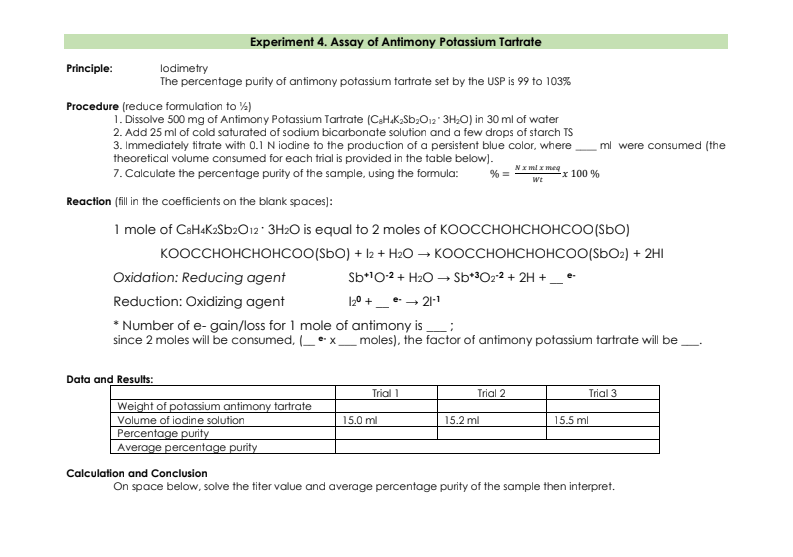Oxidation: Reducing agent Sb*10-2 + H2O –→ Sb*³Oz^² + 2H + _ Reduction: Oxidizing agent 1;0 + _ • → 21-1 * Number of e- gain/loss for 1 mole of antimony is
Oxidation: Reducing agent Sb*10-2 + H2O –→ Sb*³Oz^² + 2H + _ Reduction: Oxidizing agent 1;0 + _ • → 21-1 * Number of e- gain/loss for 1 mole of antimony is
Chemistry
10th Edition
ISBN:9781305957404
Author:Steven S. Zumdahl, Susan A. Zumdahl, Donald J. DeCoste
Publisher:Steven S. Zumdahl, Susan A. Zumdahl, Donald J. DeCoste
Chapter1: Chemical Foundations
Section: Chapter Questions
Problem 1RQ: Define and explain the differences between the following terms. a. law and theory b. theory and...
Related questions
Question
This is a practice problem

Transcribed Image Text:Experiment 4. Assay of Antimony Potassium Tartrate
Principle:
lodimetry
The percentage purity of antimony potassium tartrate set by the USP is 99 to 103%
Procedure (reduce formulation to %)
1. Dissolve 500 mg of Antimony Potassium Tartrate (CaH.K,Sb;O12" 3H;0) in 30 ml of water
2. Add 25 ml of cold saturated of sodium bicarbonate solution and a few drops of starch TS
3. Immediately titrate with 0.1 N iodine to the production of a persistent blue color, where
theoretical volume consumed for each trial is provided in the table below).
7. Calculate the percentage purity of the sample, using the formula:
ml were consumed (the
Nx ml x meg
% =
x 100 %
We
Reaction (fill in the coefficients on the blank spaces):
1 mole of CaHaK2Sb2O12 3H2O is equal to 2 moles of KOOCCHOHCHOHCOO(SbO)
коосснонснонсоO(SbO) + l2 + HаО — коосснонснонсоO(SbOг) + 2HI
Oxidation: Reducing agent
Sb*10-2 + H2O → Sb*3O22 + 2H +_ e-
Reduction: Oxidizing agent
120 +_ e- - 21-1
* Number of e- gain/loss for 1 mole of antimony is :
since 2 moles will be consumed, ••x_ moles), the factor of antimony potassium tartrate will be
Data and Results:
Trial 1
Trial 2
Trial 3
Weight of potassium antimony tartrate
Volume of iodine solution
15.0 ml
15.2 ml
15.5 ml
Percentage purity
Average percentage purity
Calculation and Conclusion
On space below, solve the titer value and average percentage purity of the sample then interpret.
Expert Solution
This question has been solved!
Explore an expertly crafted, step-by-step solution for a thorough understanding of key concepts.
Step by step
Solved in 5 steps with 7 images

Knowledge Booster
Learn more about
Need a deep-dive on the concept behind this application? Look no further. Learn more about this topic, chemistry and related others by exploring similar questions and additional content below.Recommended textbooks for you

Chemistry
Chemistry
ISBN:
9781305957404
Author:
Steven S. Zumdahl, Susan A. Zumdahl, Donald J. DeCoste
Publisher:
Cengage Learning

Chemistry
Chemistry
ISBN:
9781259911156
Author:
Raymond Chang Dr., Jason Overby Professor
Publisher:
McGraw-Hill Education

Principles of Instrumental Analysis
Chemistry
ISBN:
9781305577213
Author:
Douglas A. Skoog, F. James Holler, Stanley R. Crouch
Publisher:
Cengage Learning

Chemistry
Chemistry
ISBN:
9781305957404
Author:
Steven S. Zumdahl, Susan A. Zumdahl, Donald J. DeCoste
Publisher:
Cengage Learning

Chemistry
Chemistry
ISBN:
9781259911156
Author:
Raymond Chang Dr., Jason Overby Professor
Publisher:
McGraw-Hill Education

Principles of Instrumental Analysis
Chemistry
ISBN:
9781305577213
Author:
Douglas A. Skoog, F. James Holler, Stanley R. Crouch
Publisher:
Cengage Learning

Organic Chemistry
Chemistry
ISBN:
9780078021558
Author:
Janice Gorzynski Smith Dr.
Publisher:
McGraw-Hill Education

Chemistry: Principles and Reactions
Chemistry
ISBN:
9781305079373
Author:
William L. Masterton, Cecile N. Hurley
Publisher:
Cengage Learning

Elementary Principles of Chemical Processes, Bind…
Chemistry
ISBN:
9781118431221
Author:
Richard M. Felder, Ronald W. Rousseau, Lisa G. Bullard
Publisher:
WILEY